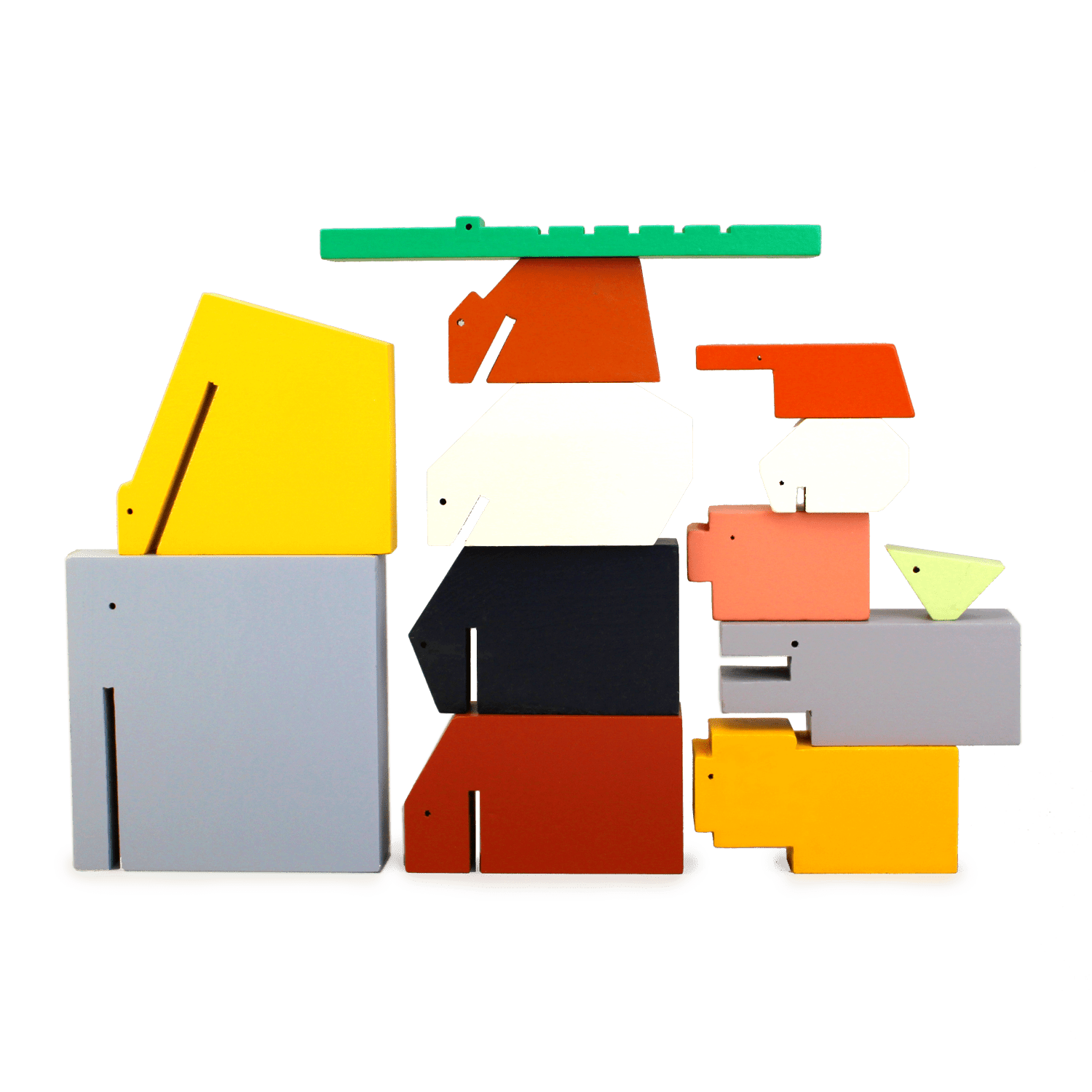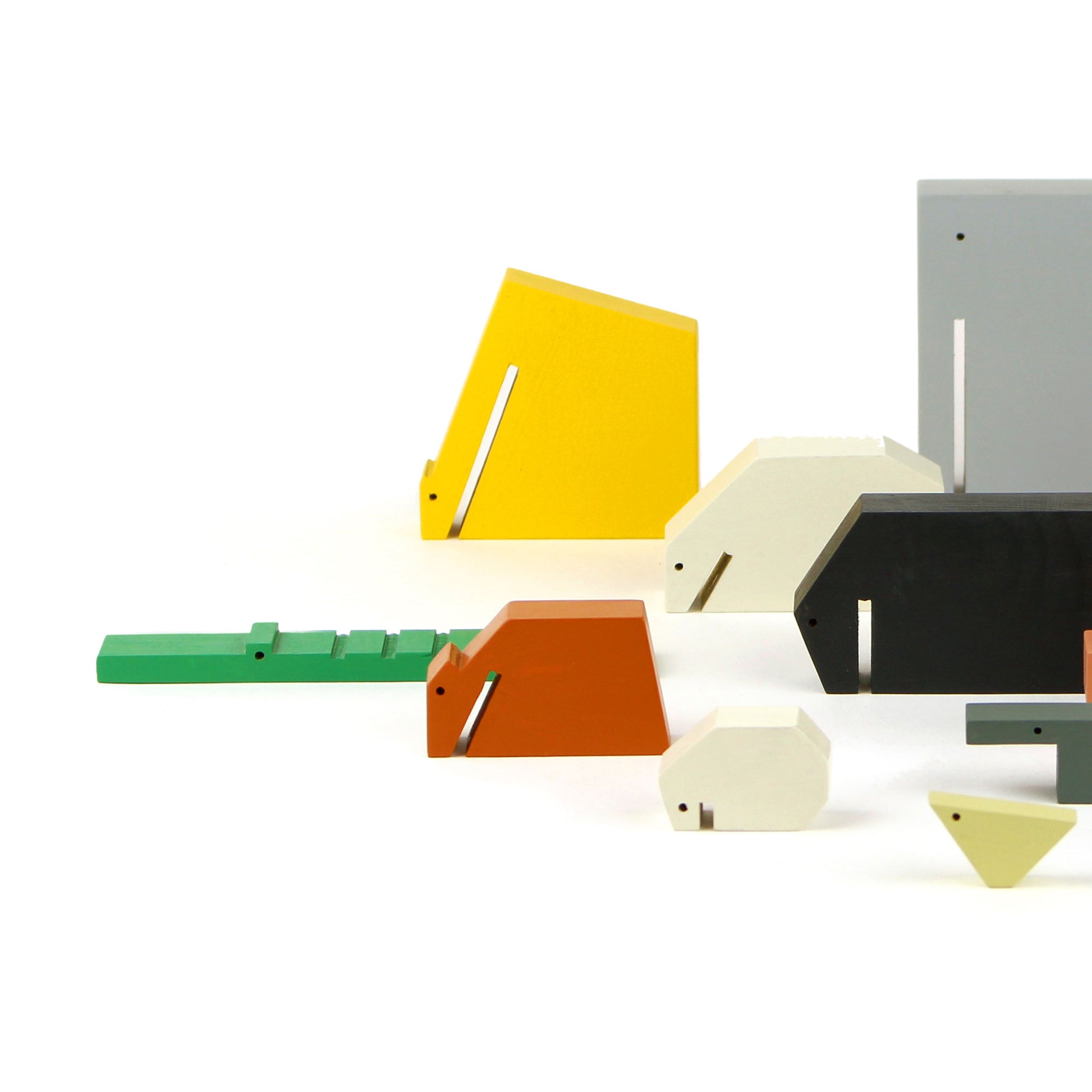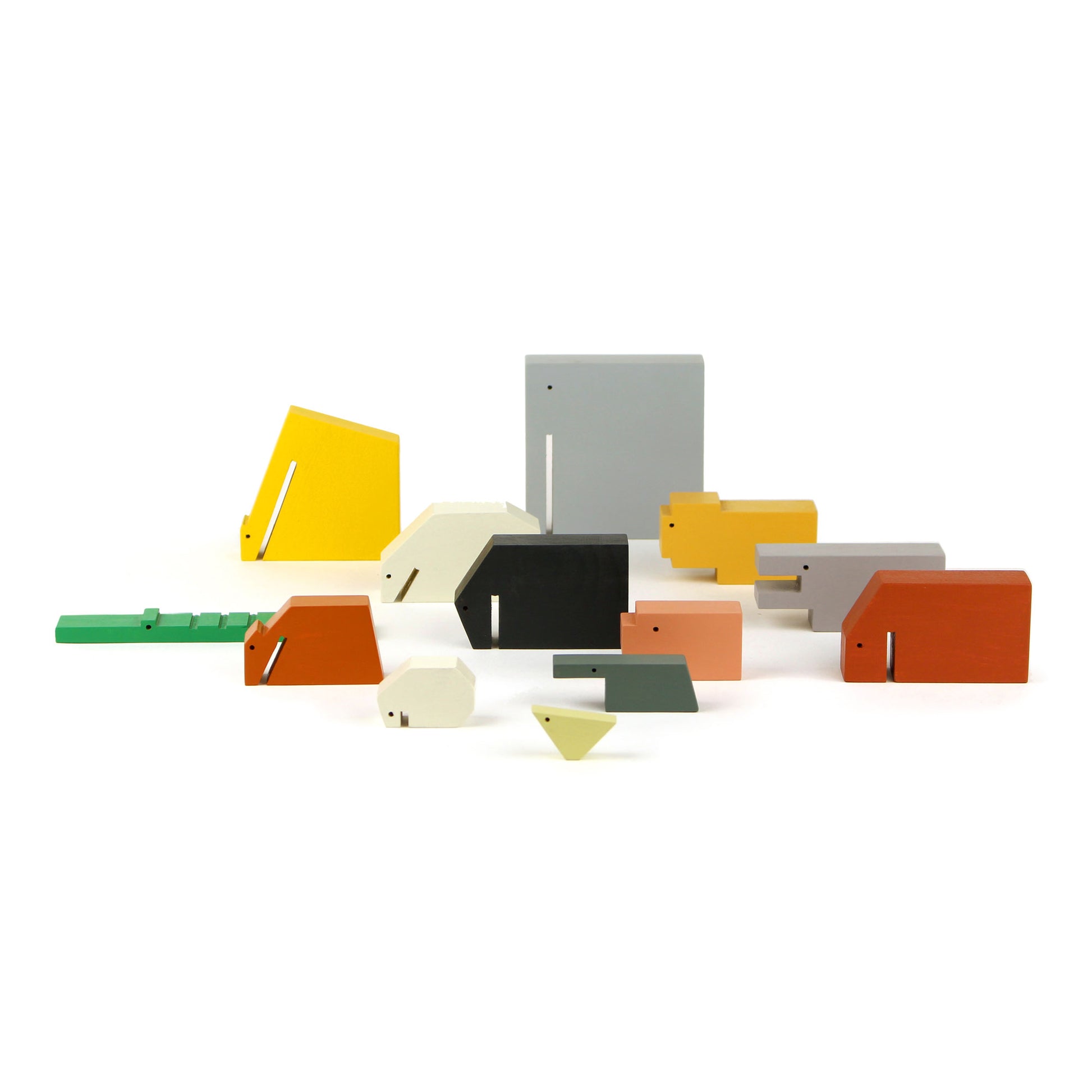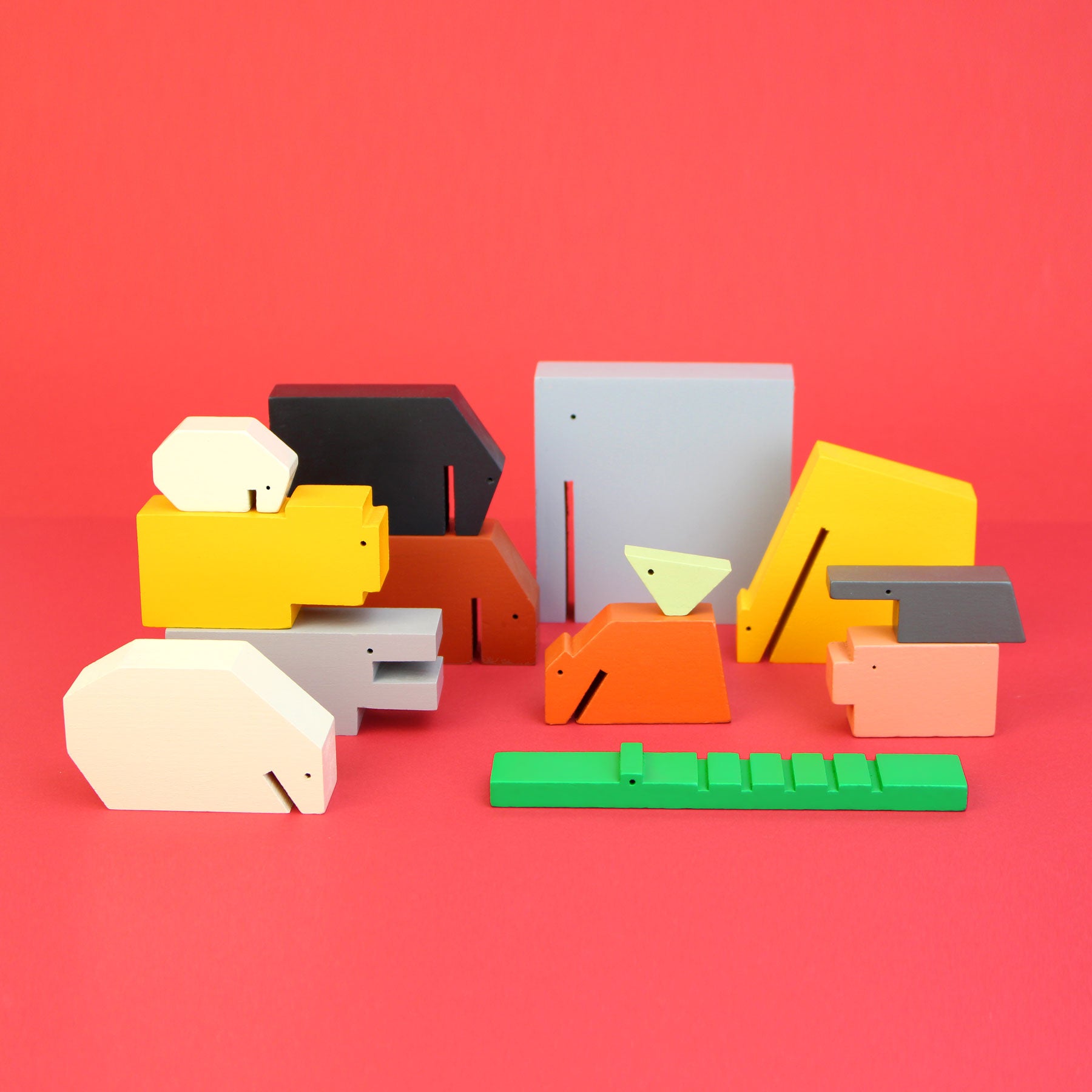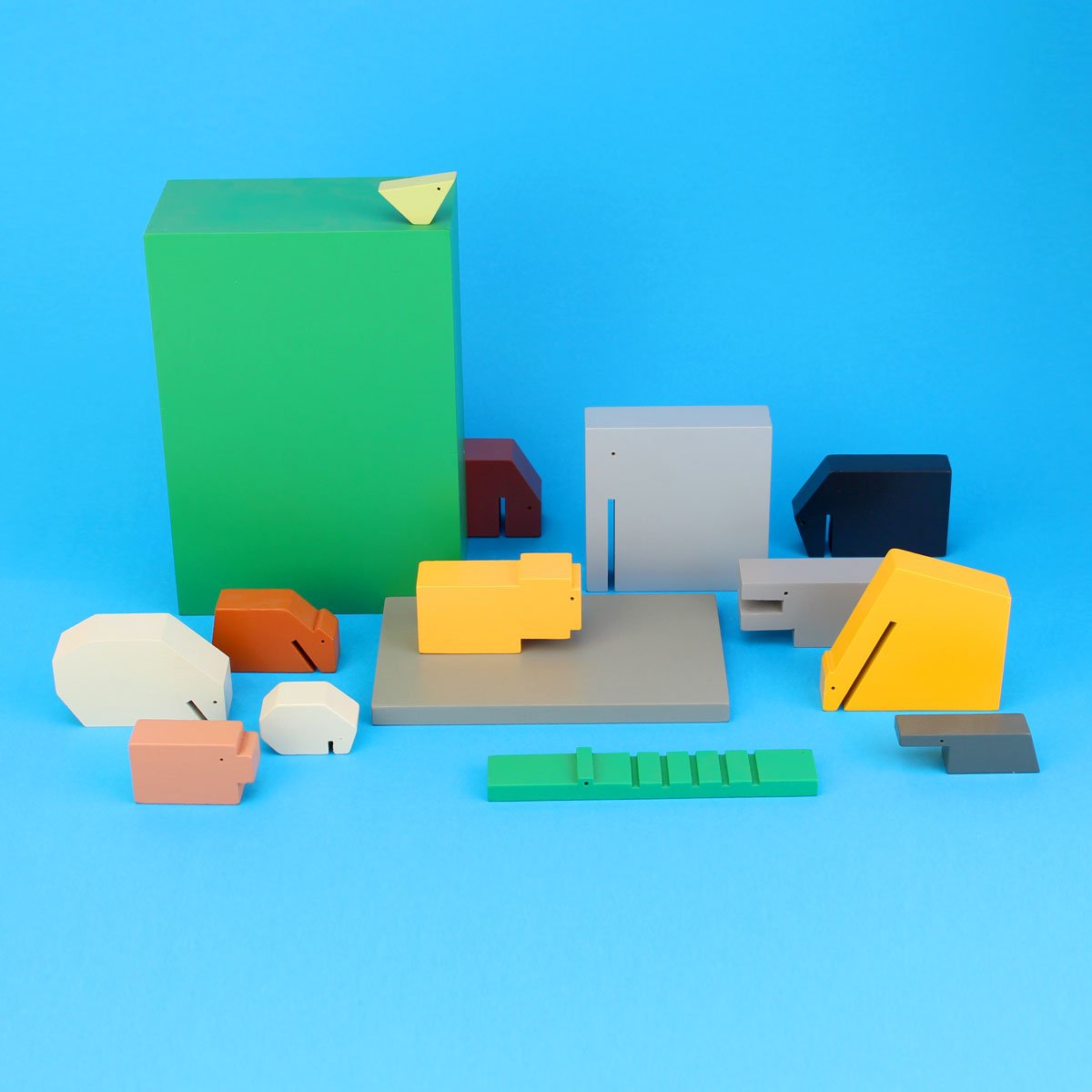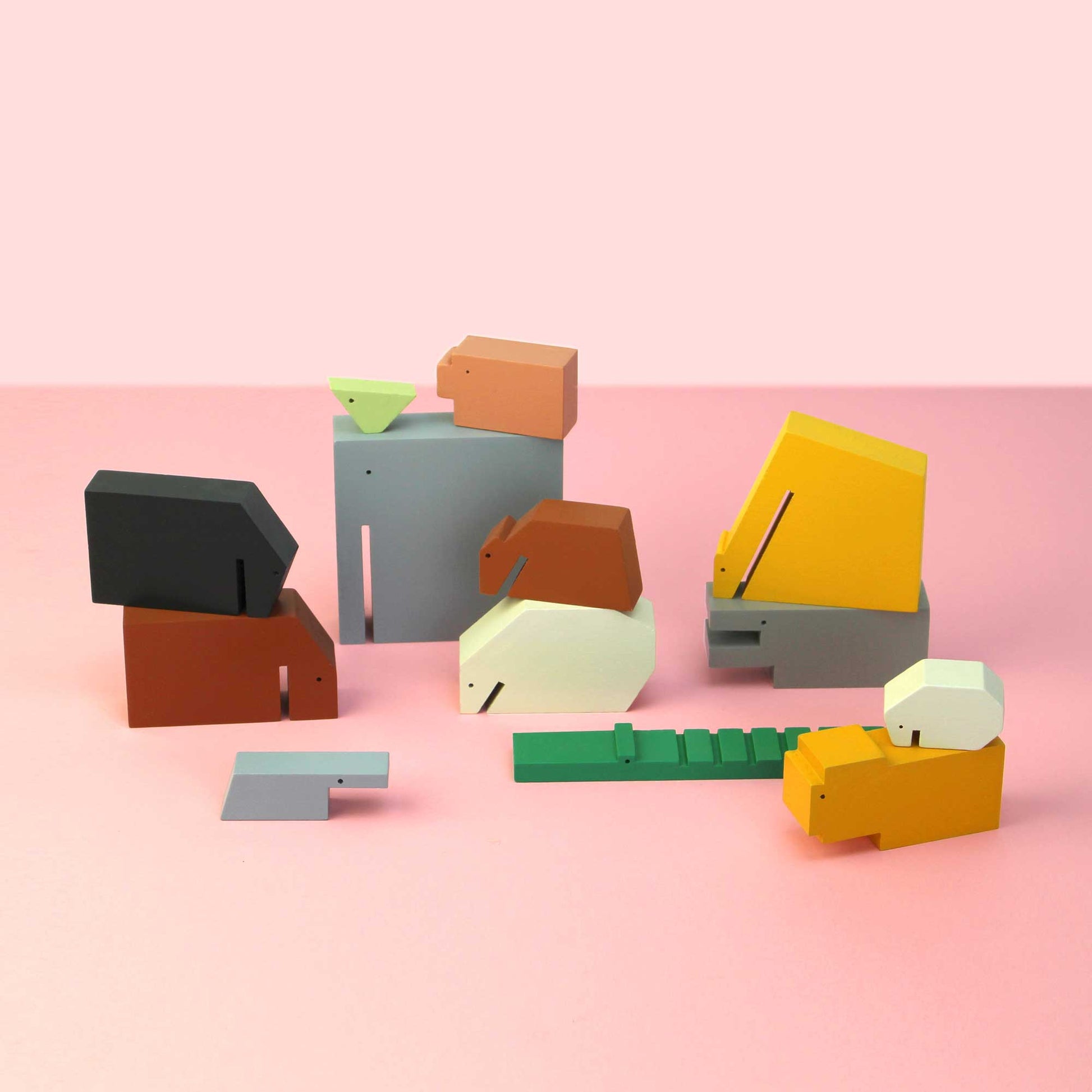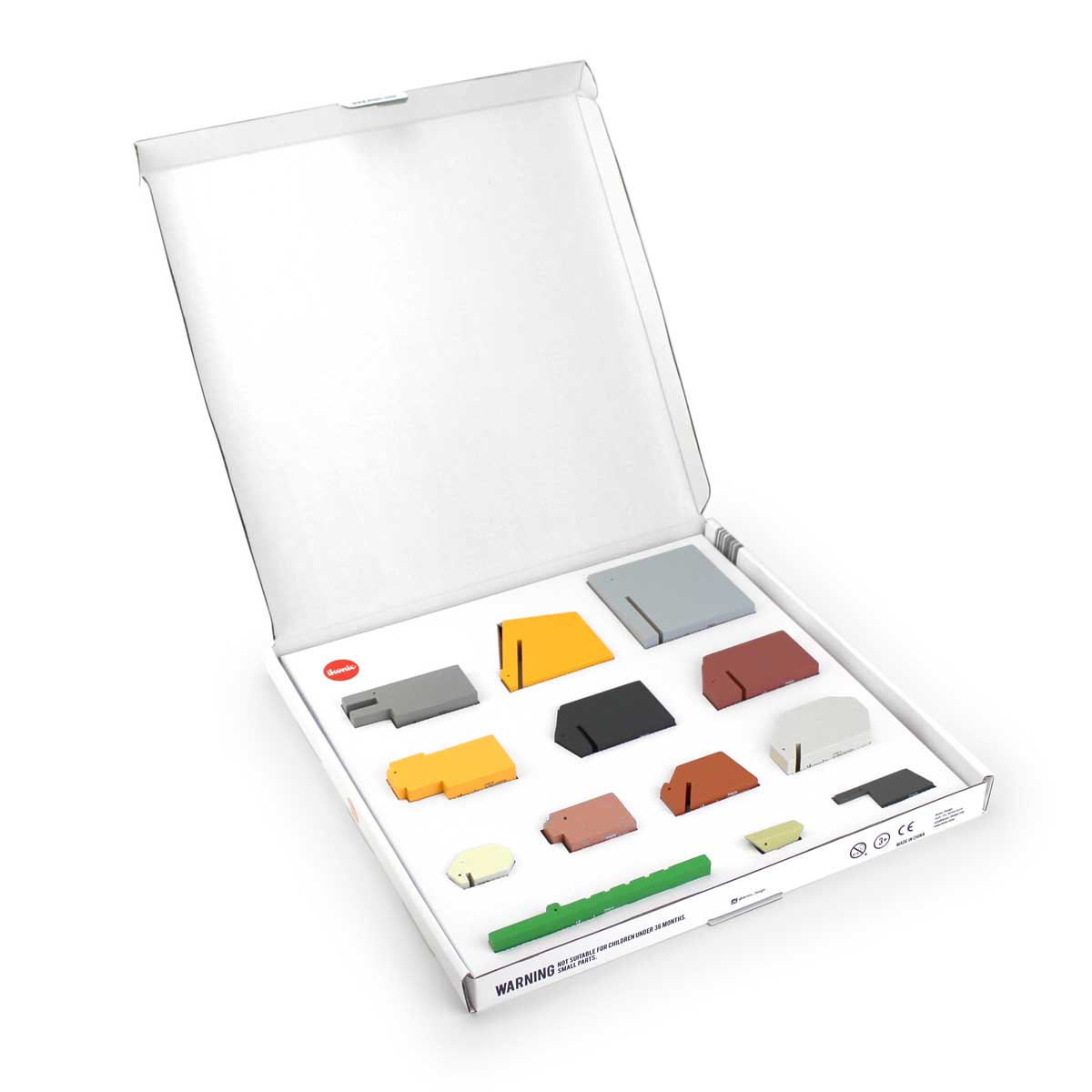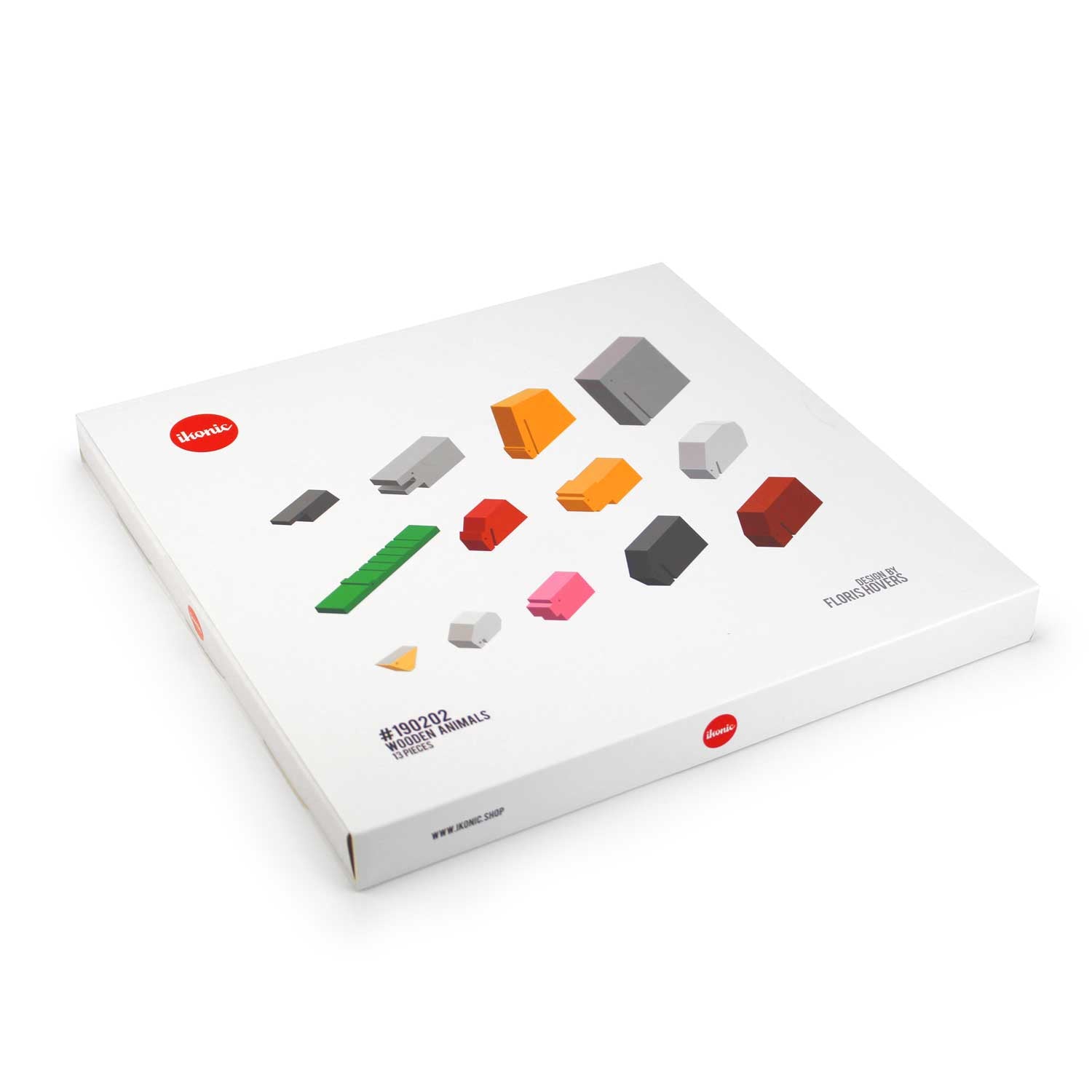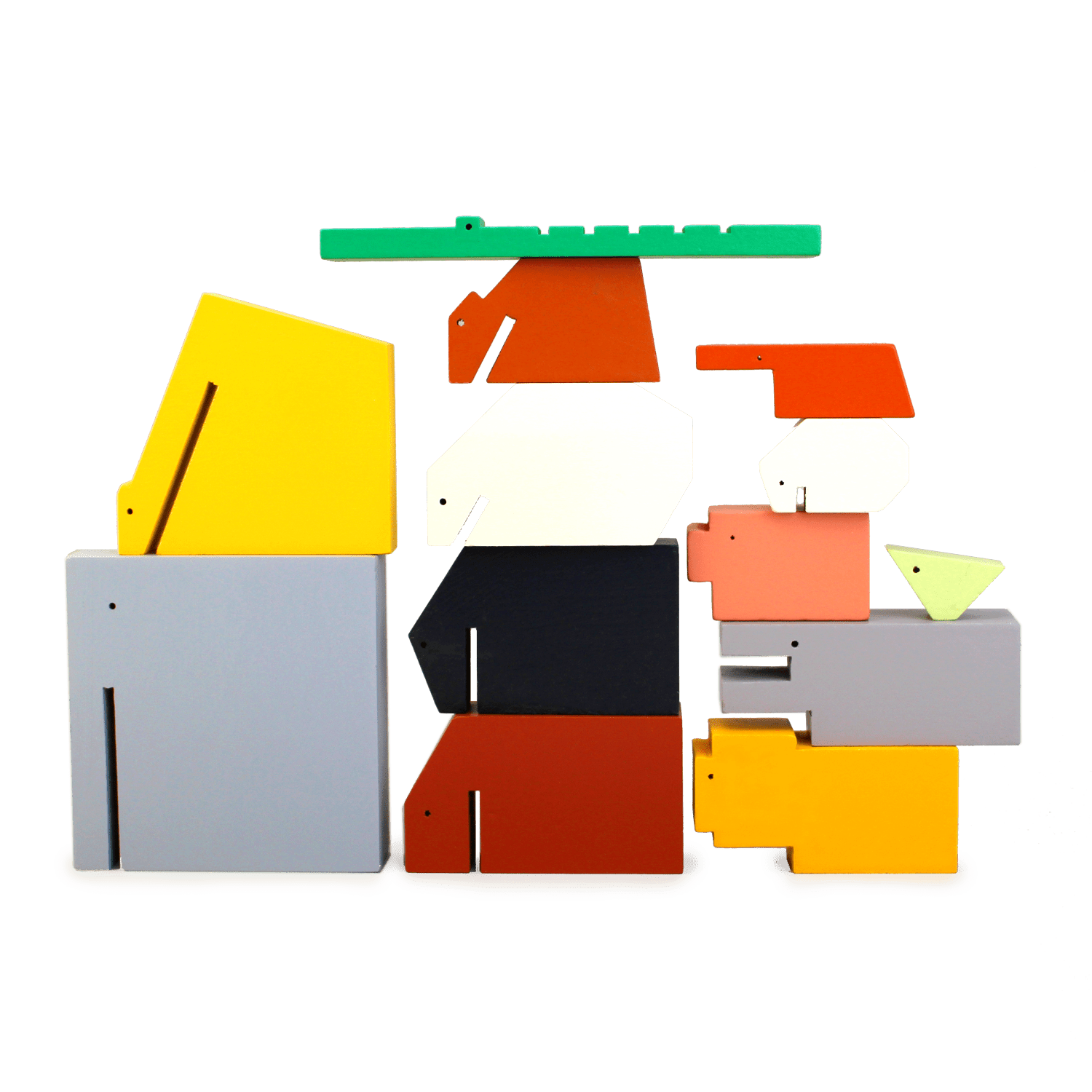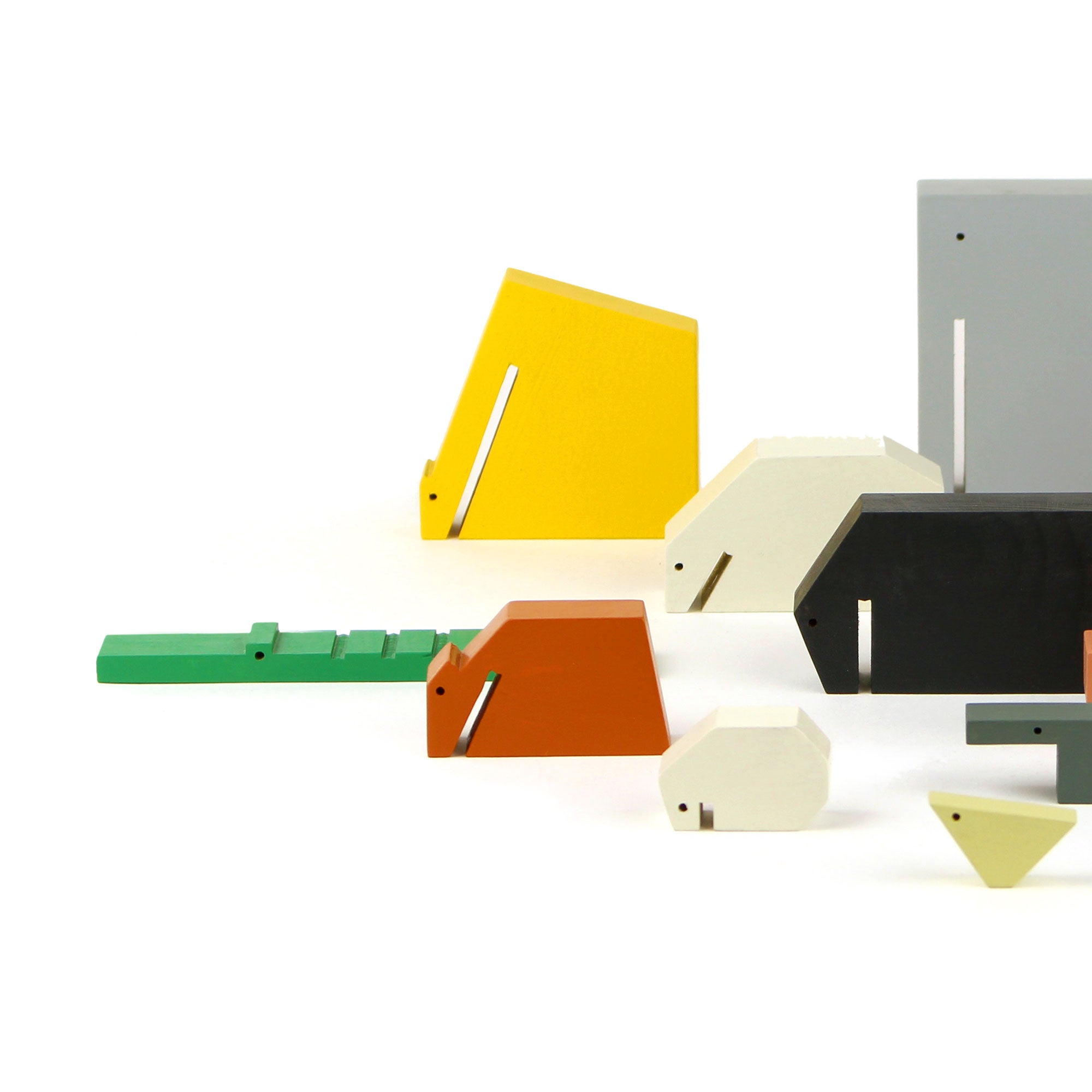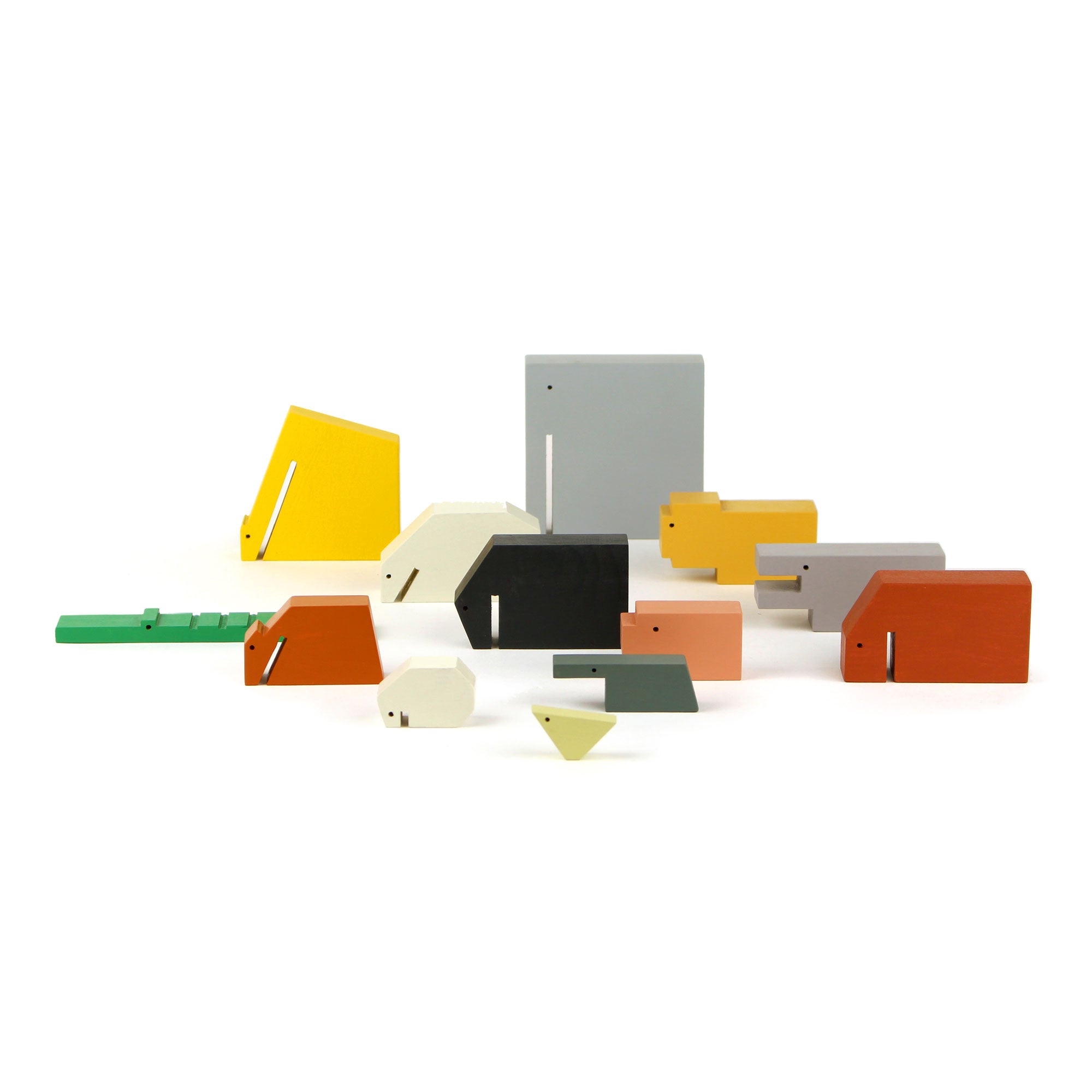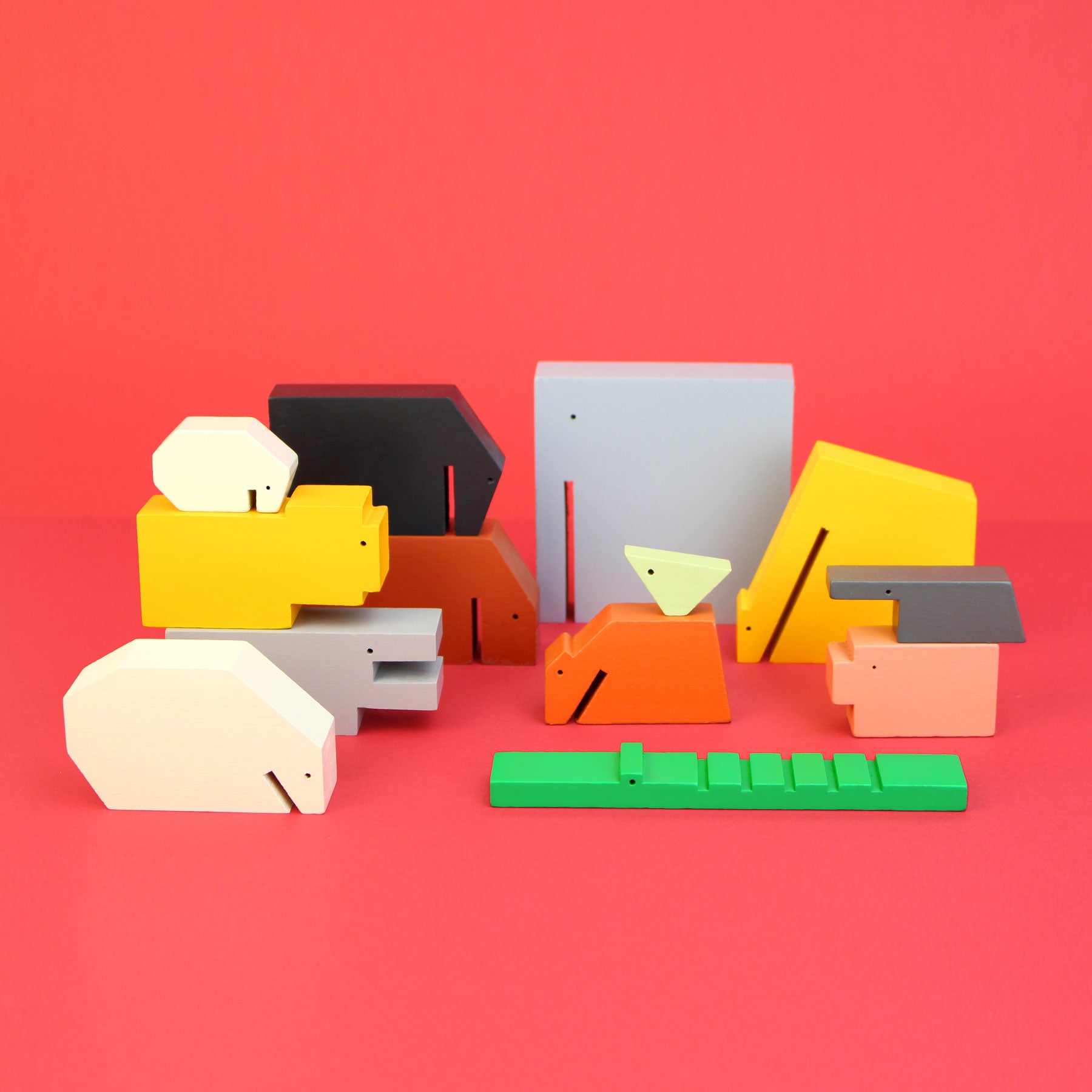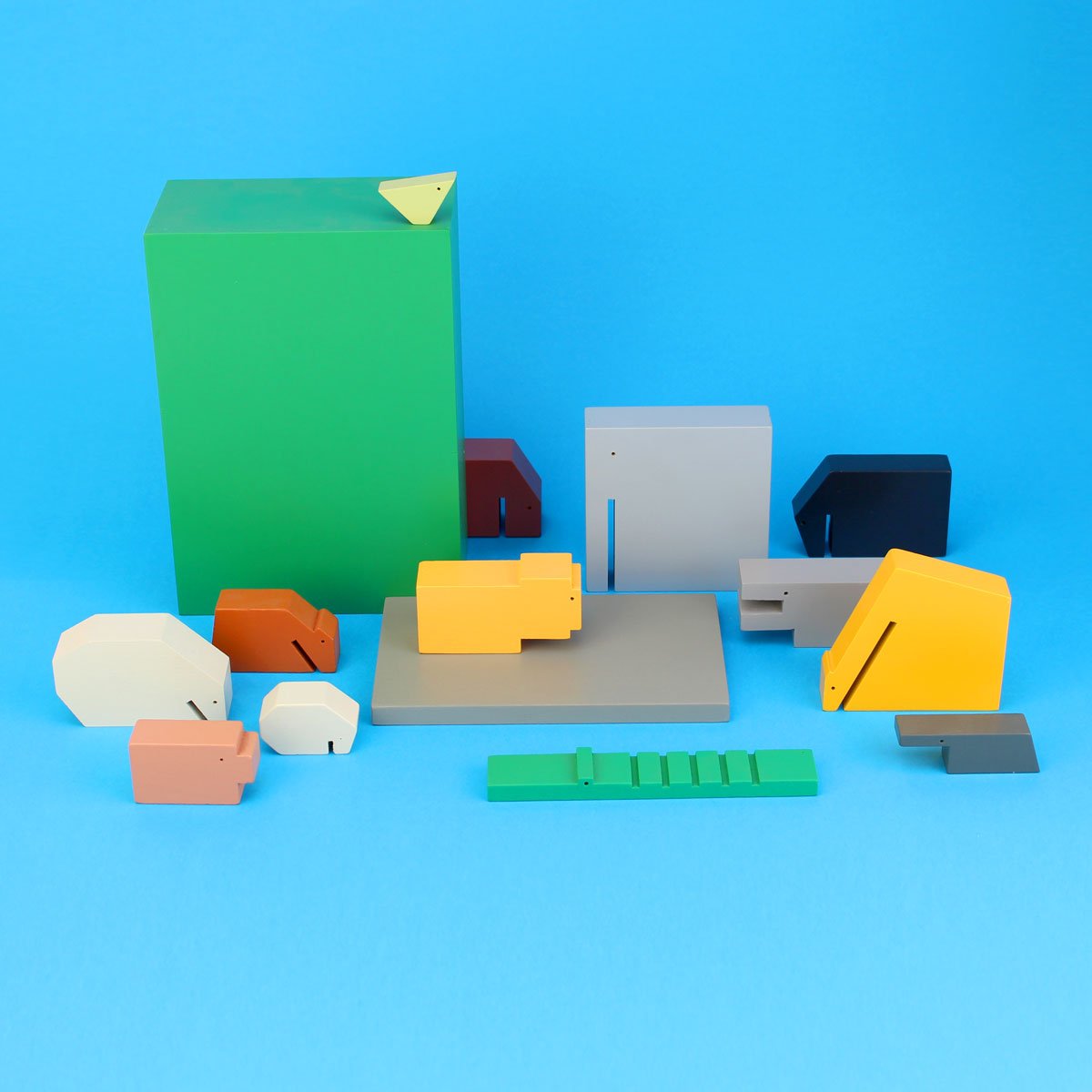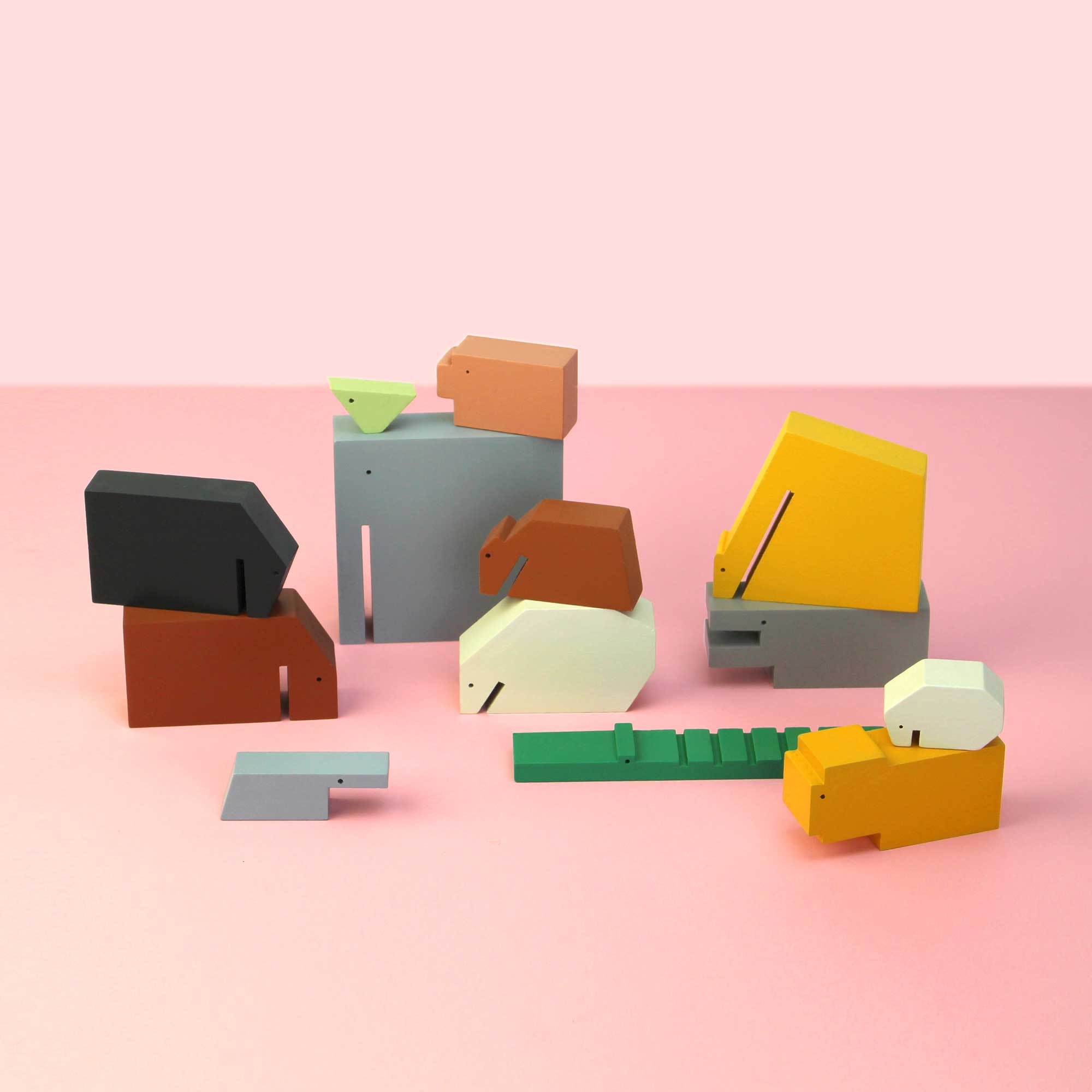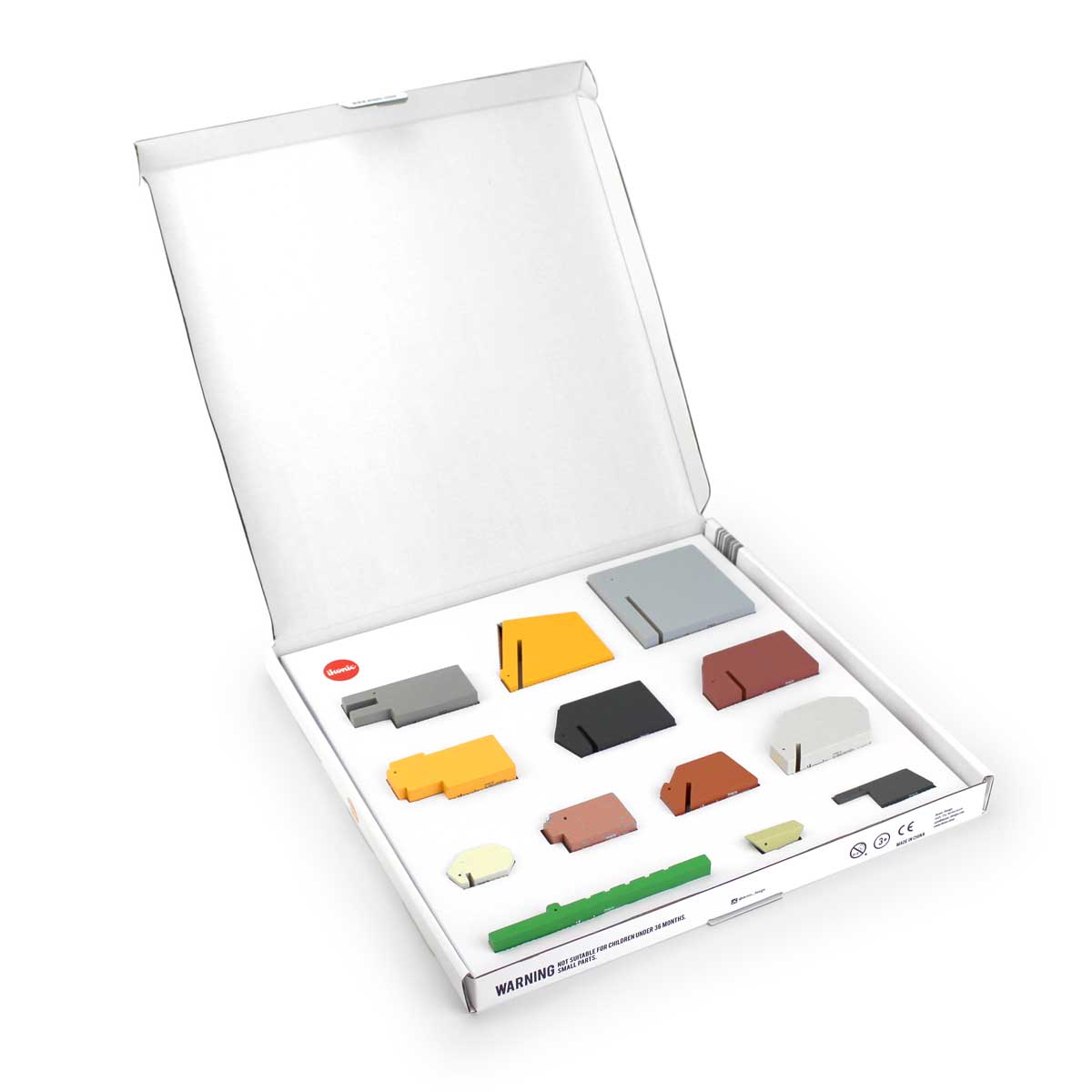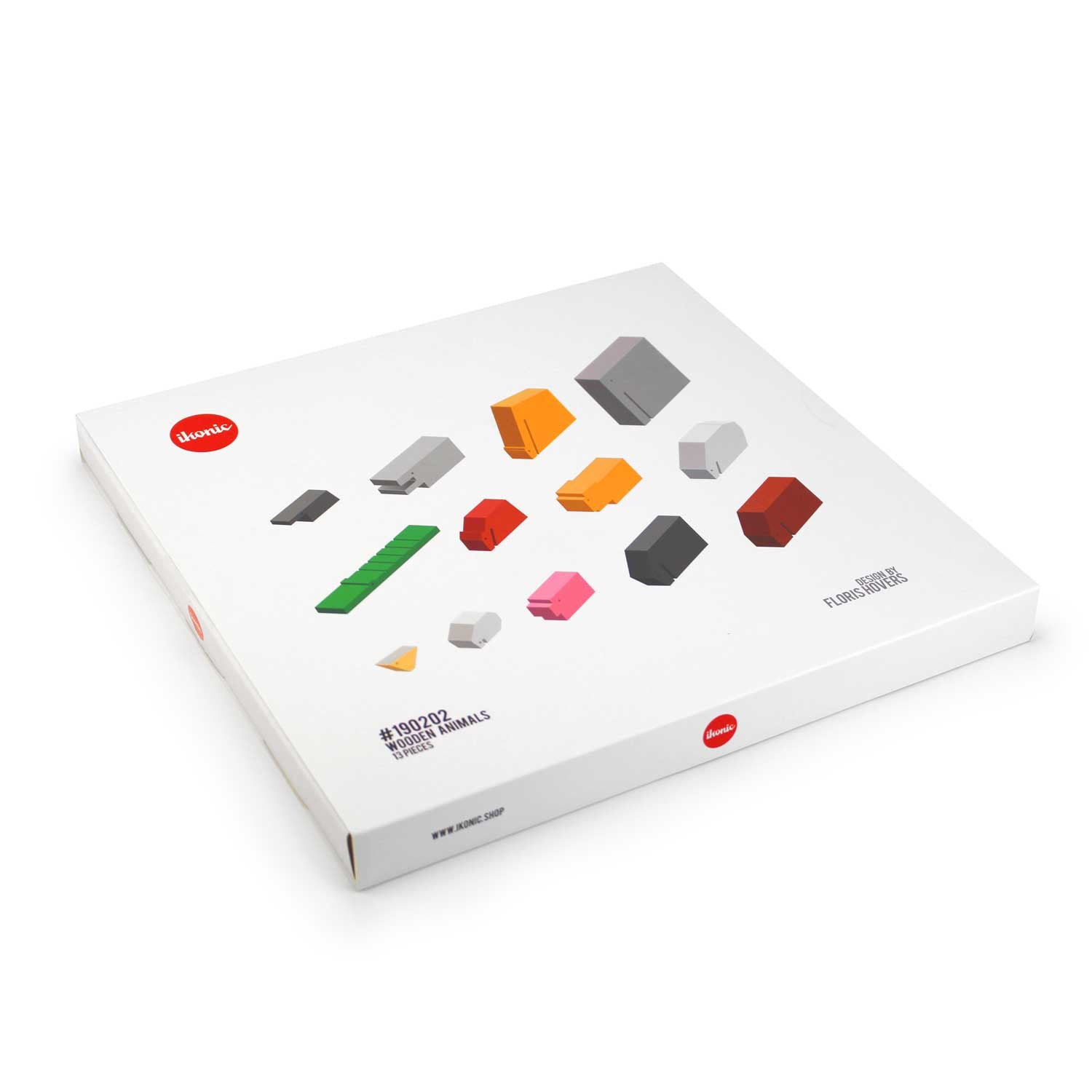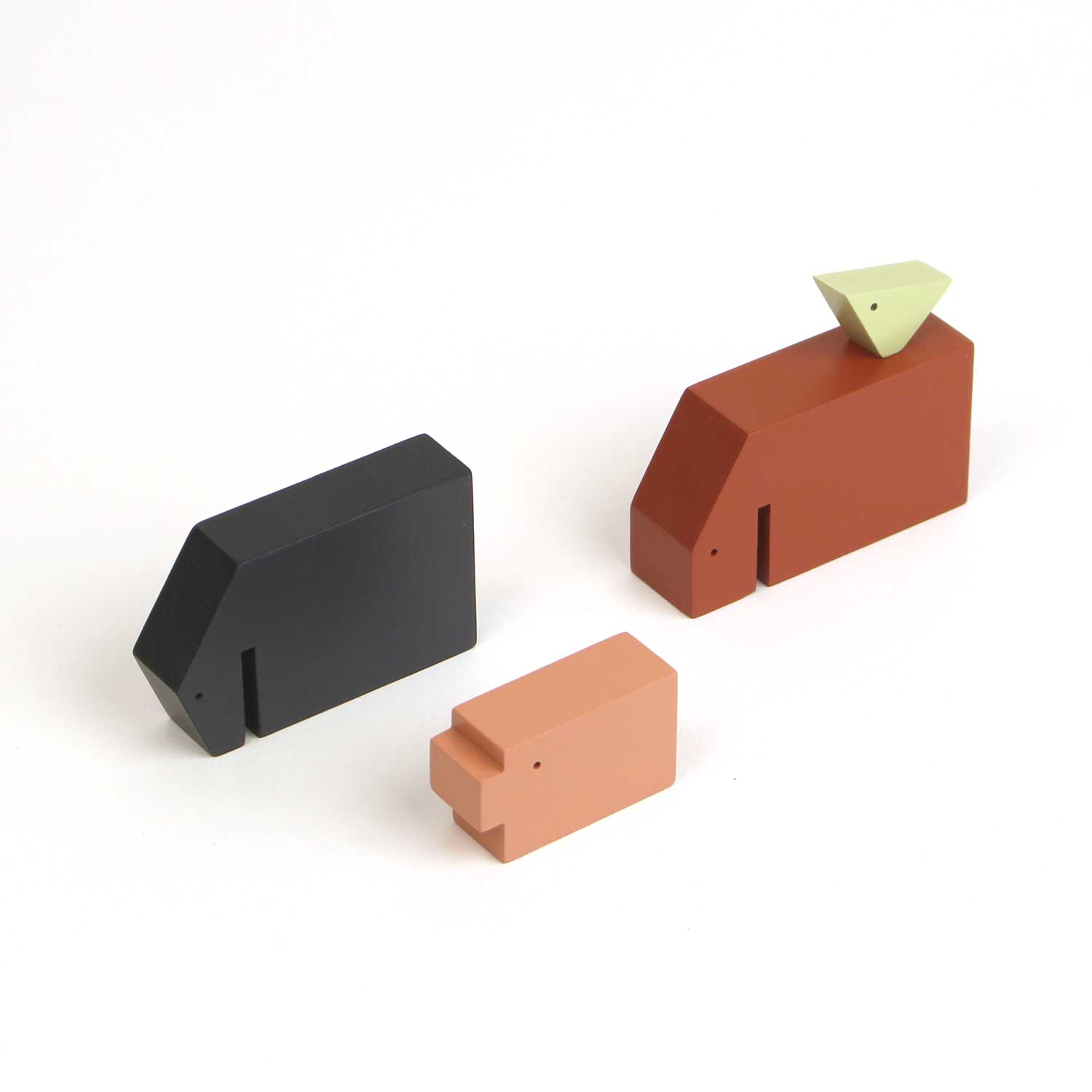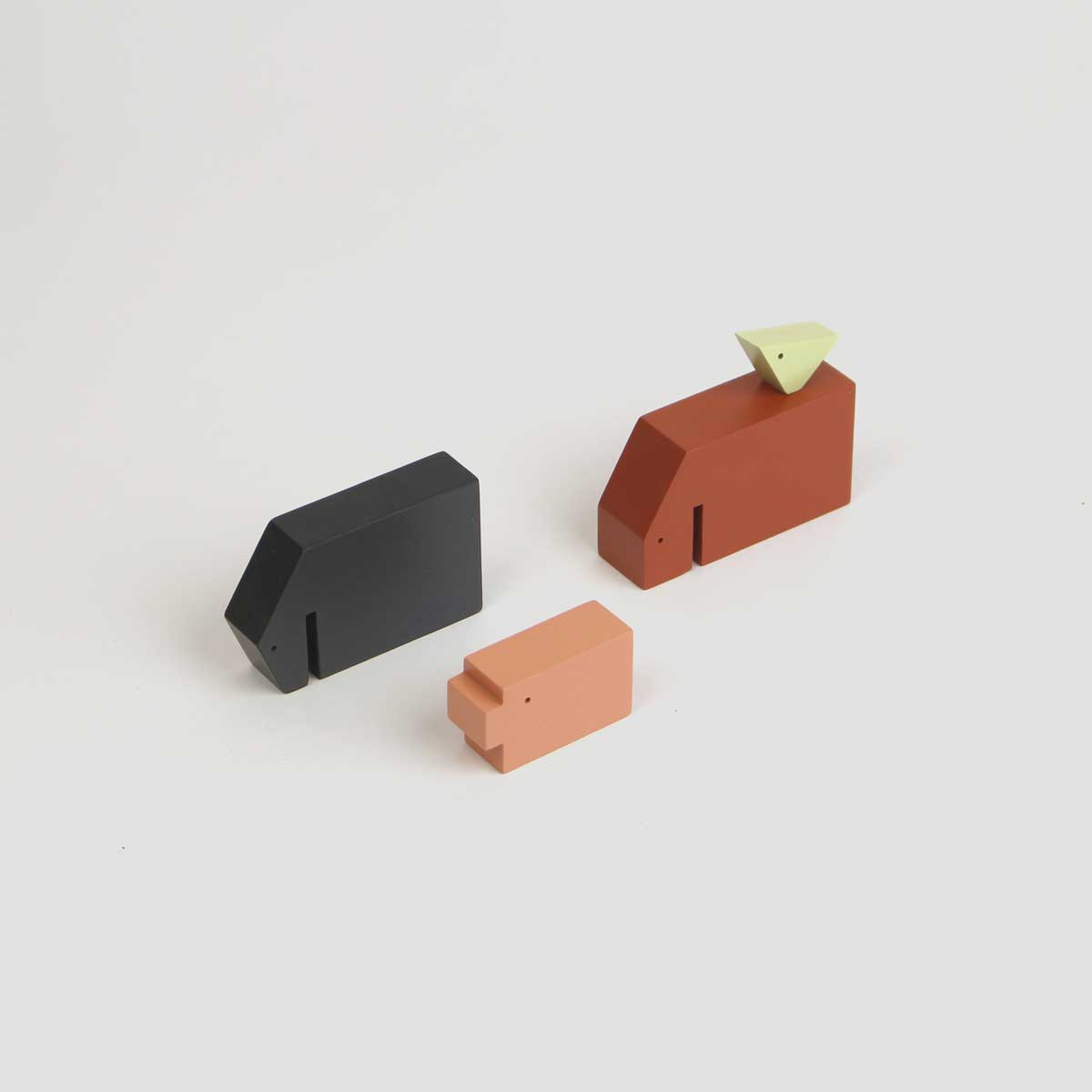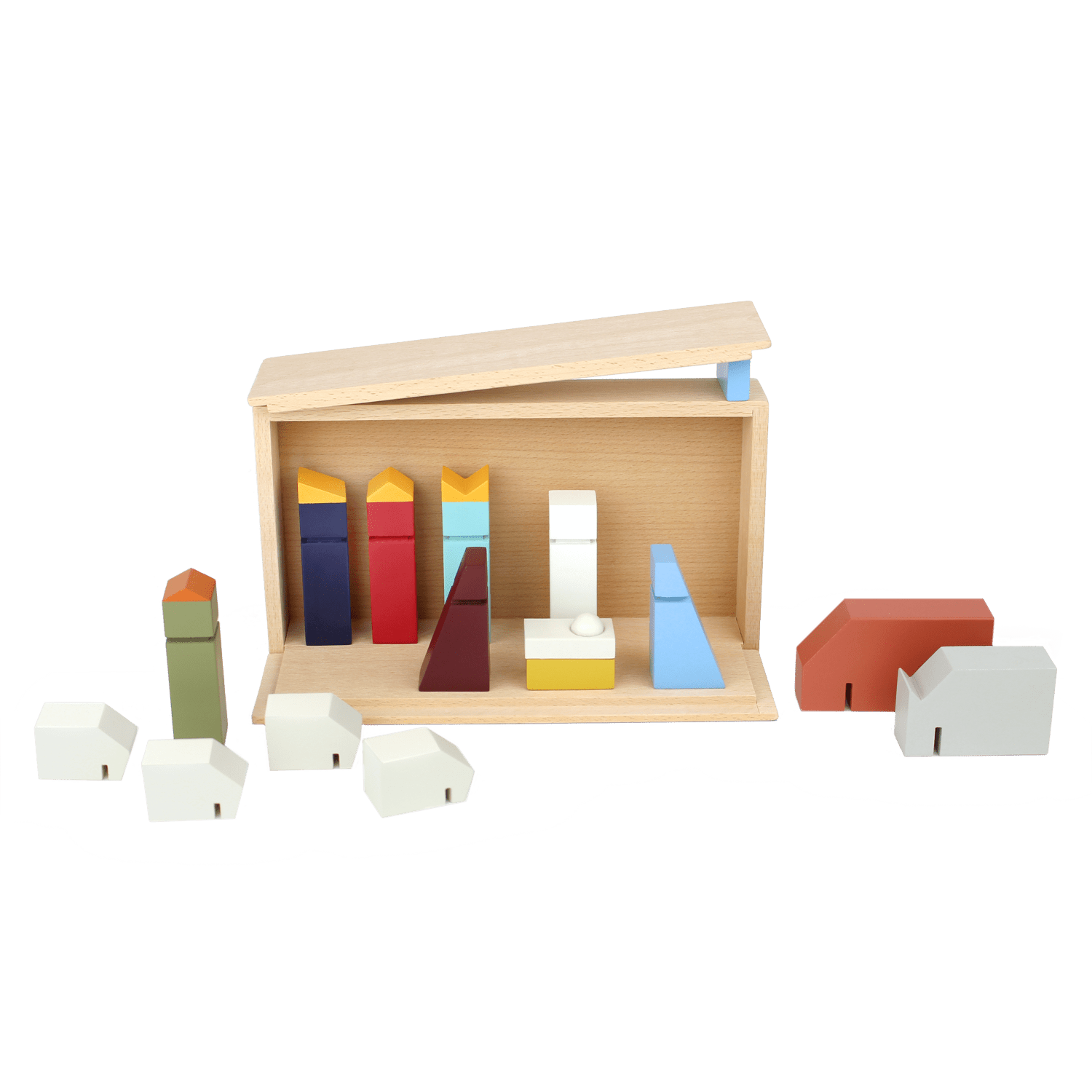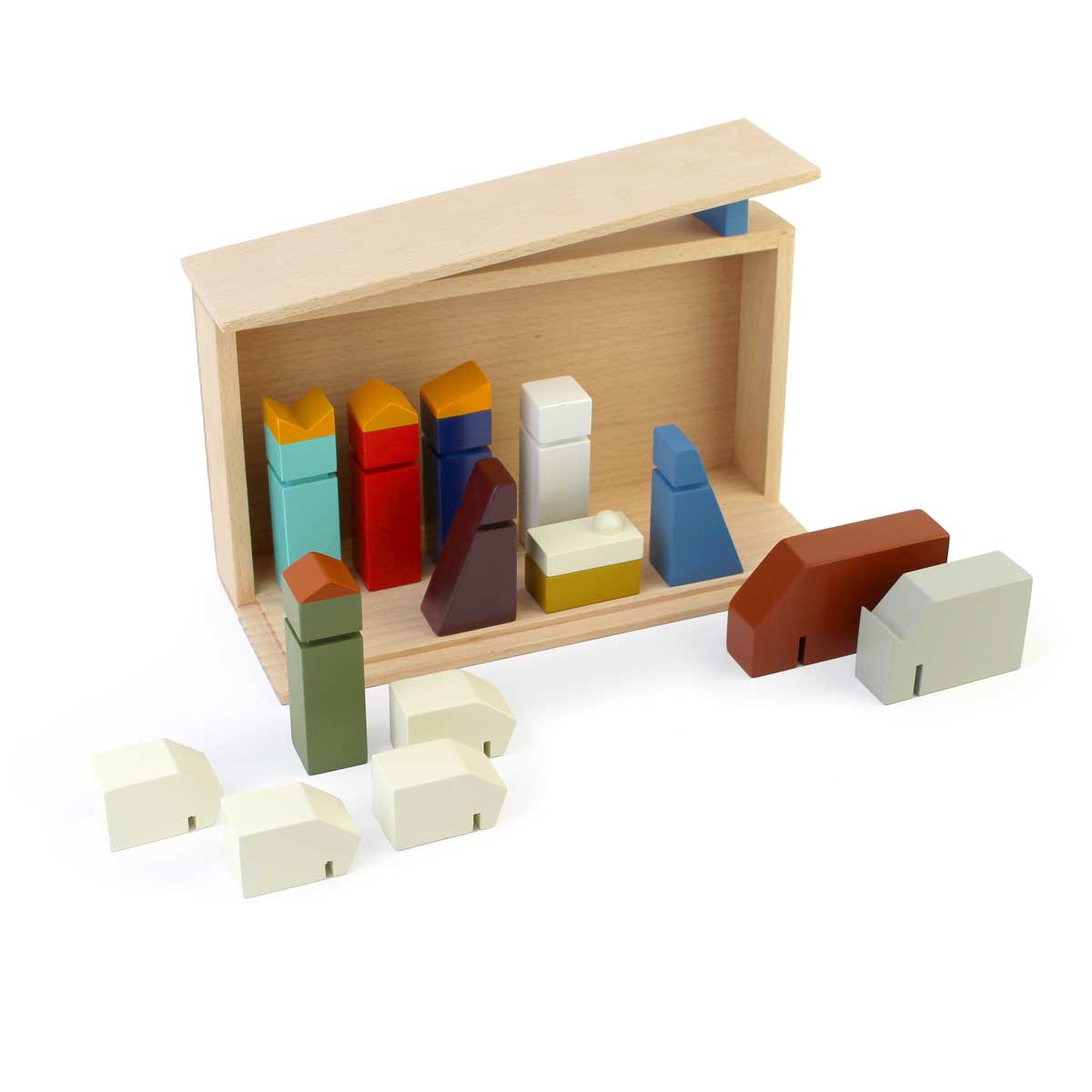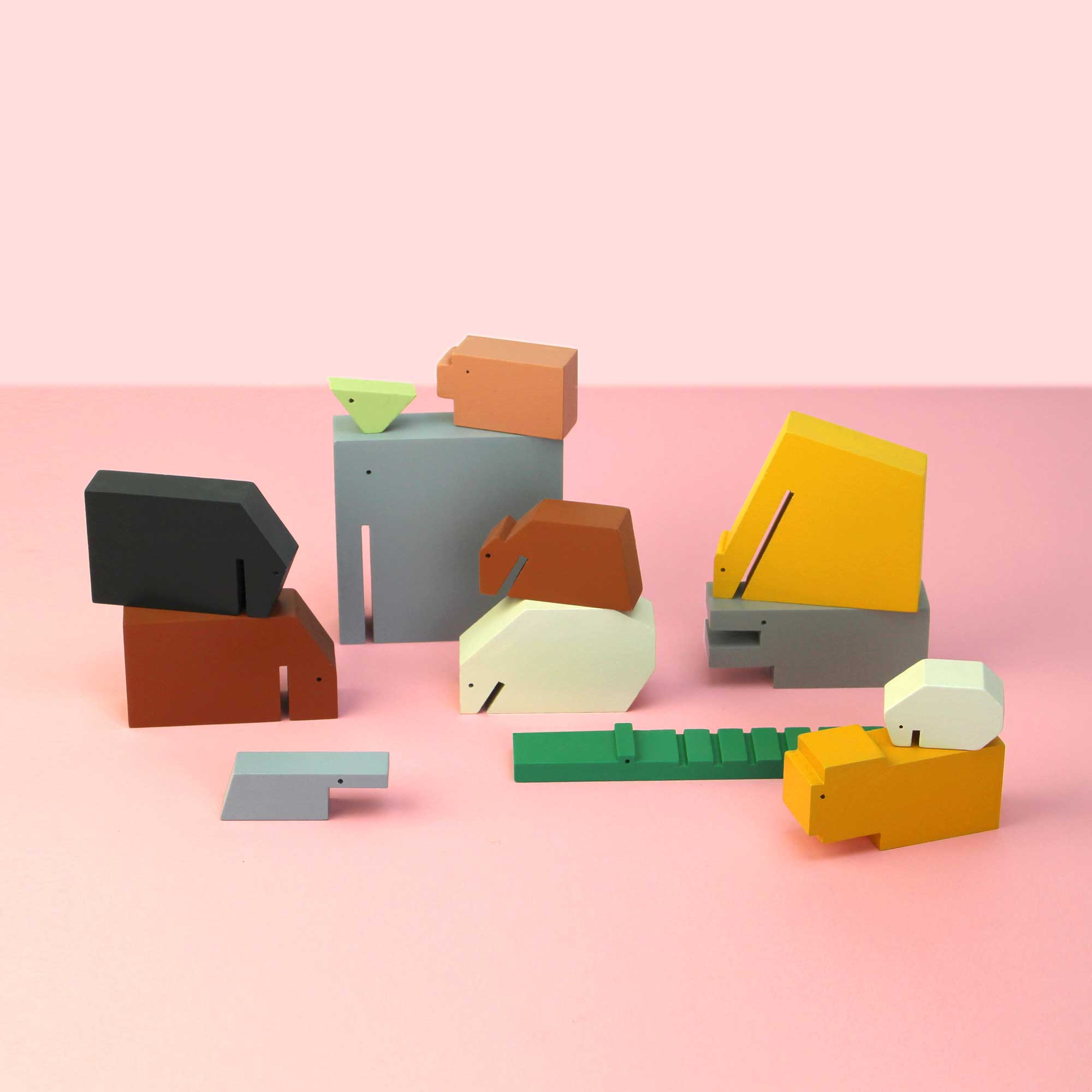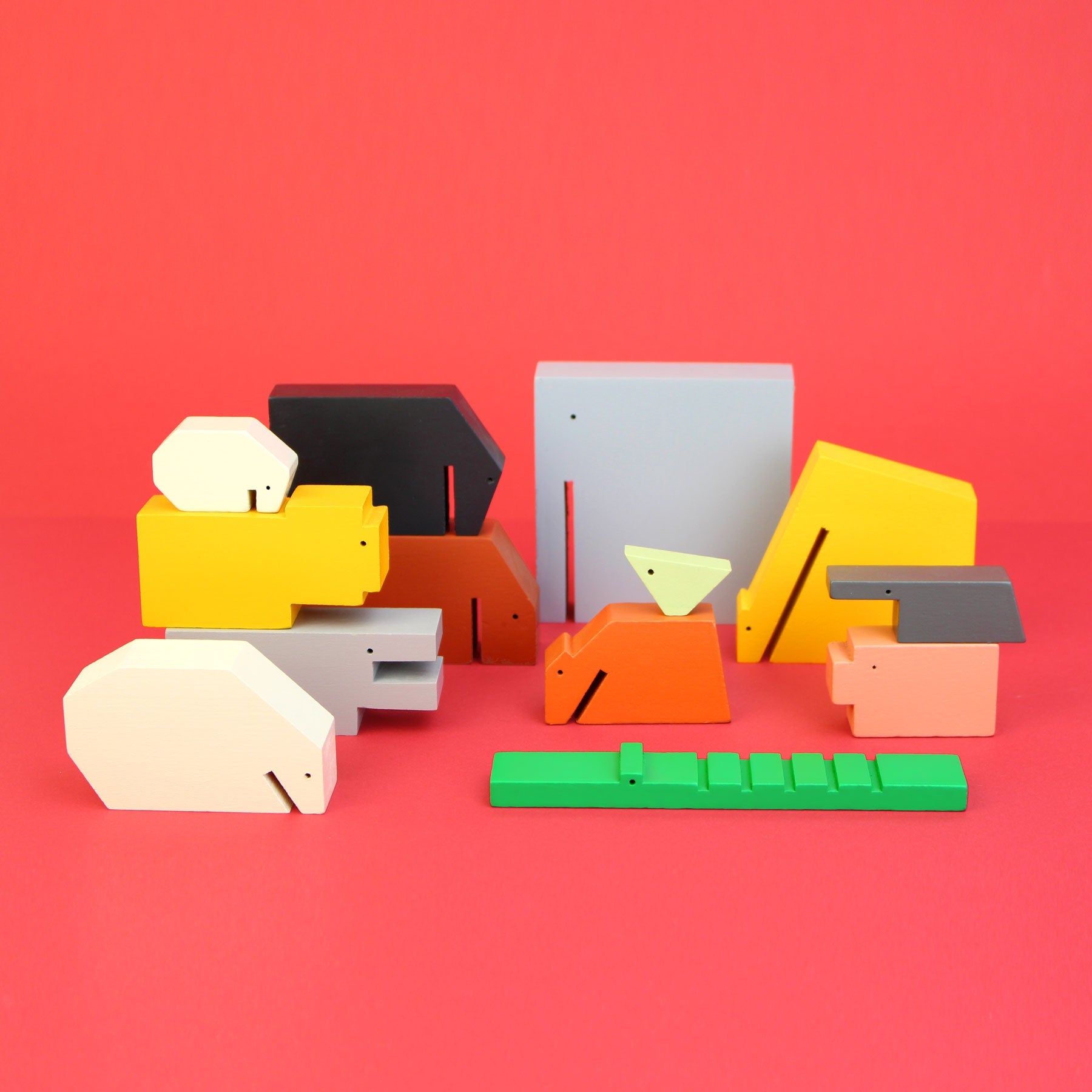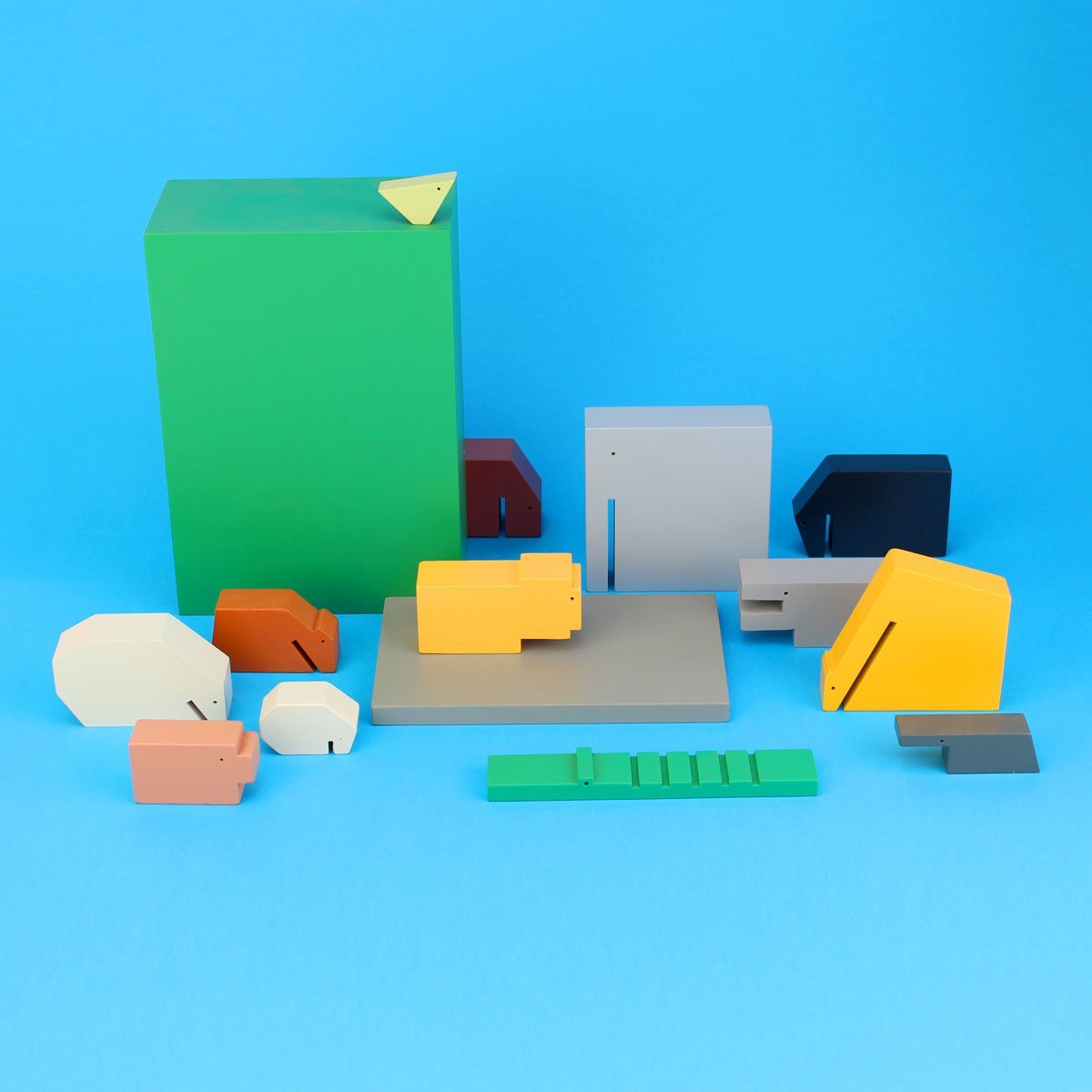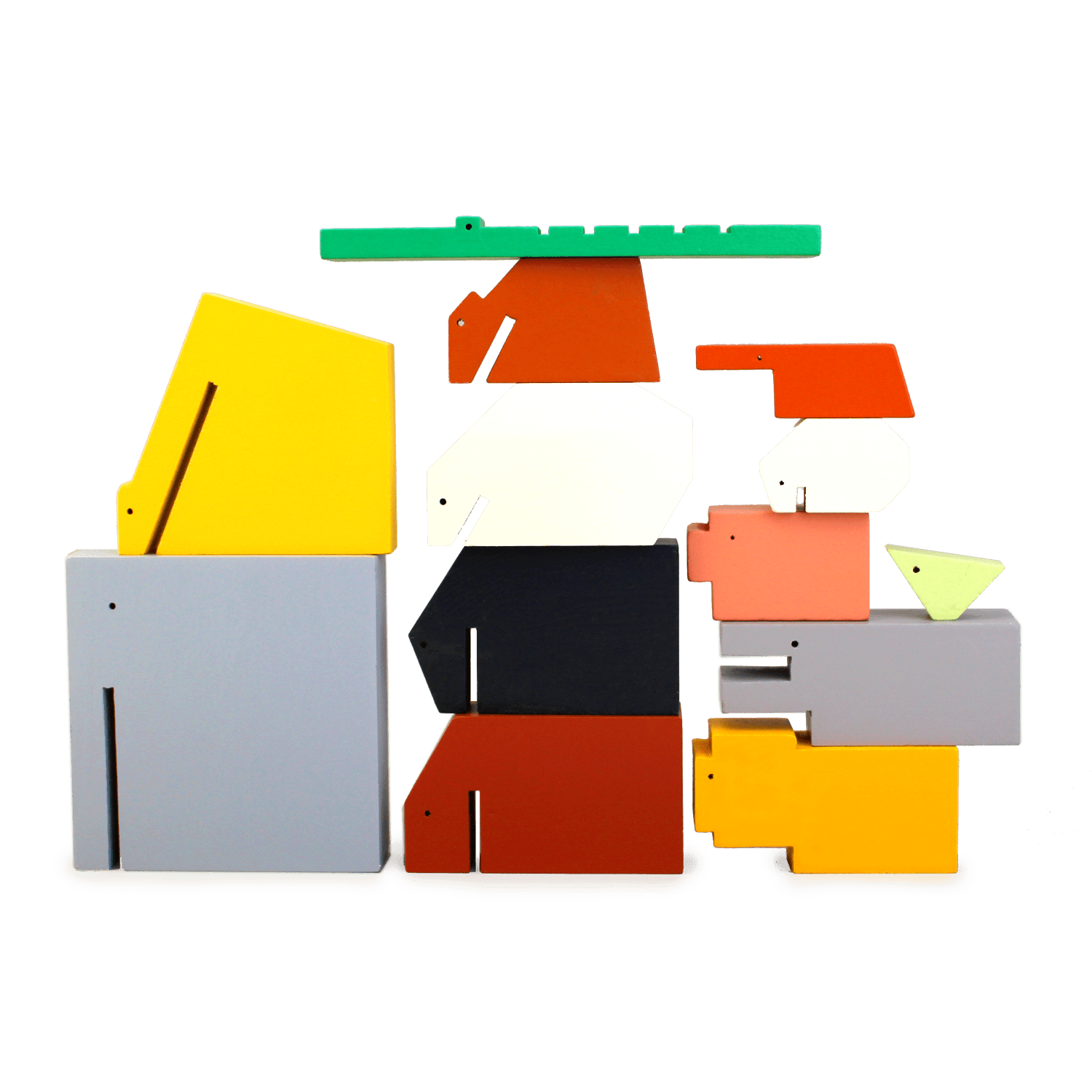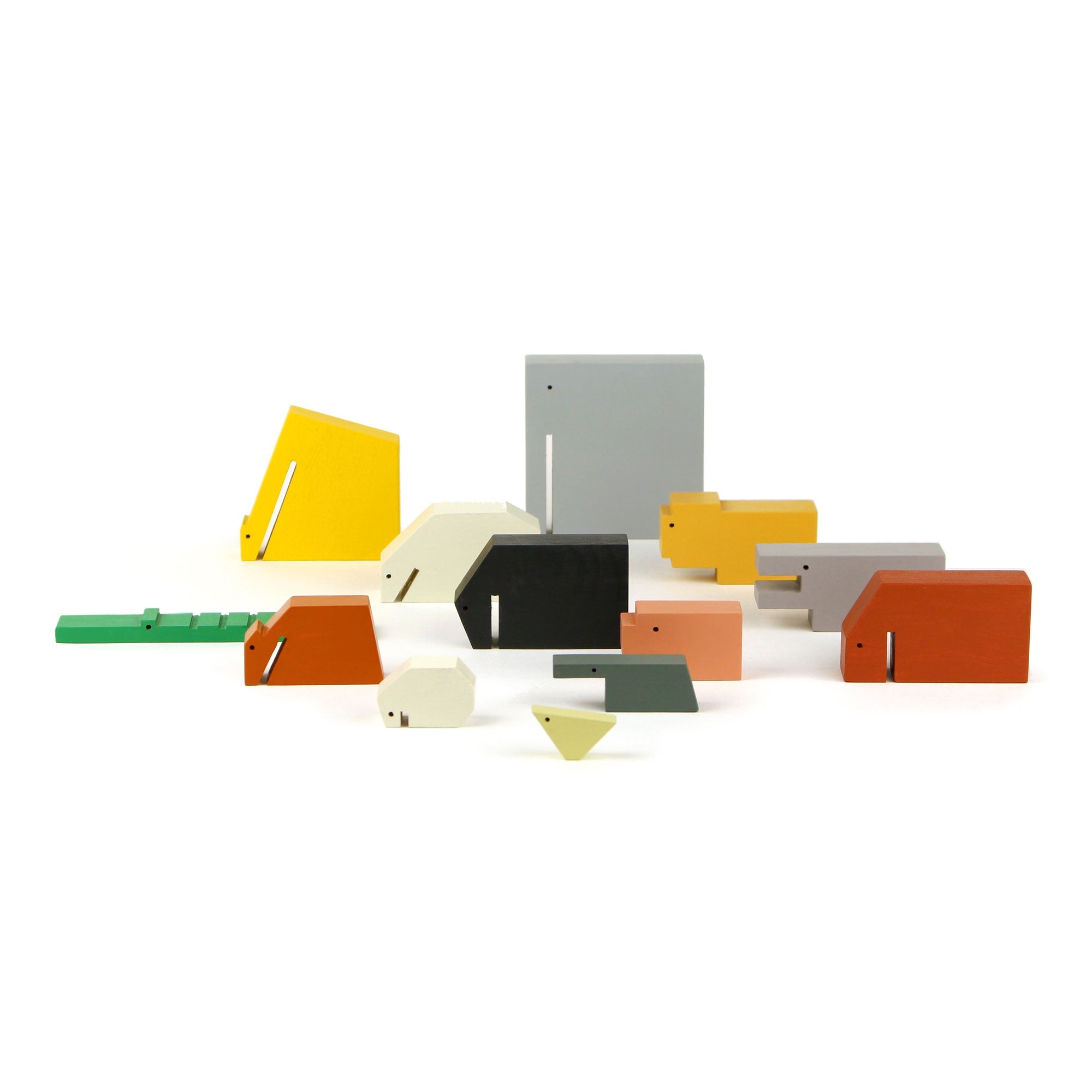
Wooden Zoo Animals
Floris Hovers Wooden Animals
In stock
Wooden Animal Set, 13 pieces
The well-known wooden animals in a new, contemporary design. Designer Floris Hovers (1976) has designed this series of modern, minimalist wooden animals. The series consists of 13 stylized farm and zoo animals, and bears the characteristic signature of Floris Hovers. The shapes of the wooden animals have been reduced to the absolute essence, and the combination with the strong use of color results in a powerful composition for which the designer is known.
Material: beech wood
Packaging: gift box
Size indication:
- crocodile: 140 x 24 x 8 mm
- elephant: 90 x 24 x 90 mm
- giraffe: 79 x 19 x 74 mm
- hippopotamus: 85 x 24 x 36 mm
This contemporary, colorful wooden animal set fits perfectly in the modern children's room or interior. Playable Dutch Design, the wooden animals are not only fun to play with, they are also an asset to the interior. The modern wooden animals are packed in a beautiful gift box.
This special set is a real collector's item for art and design lovers, but is also certainly suitable as a special gift. Suitable for everyone aged 3 years and older. This beechwood toy set meets all European toy safety requirements .
Share this product
Everything you need to know about wooden zoo toys
Why choose wooden zoo animals?
More and more parents and educators are consciously choosing wooden zoo toys. It not only looks beautiful in the room, but is also durable, safe and timeless. Wooden animals and entire zoos encourage imaginative play, are often handmade from natural materials and last for generations. This choice is in line with a growing awareness of sustainability, health and the influence of toys on children's development. Moreover, wooden zoo animals fit nicely into any interior and still look attractive even after years of playing.
Yet the subject raises many questions. From safety and quality to which brands to consider, how long wooden zoo toys last, and how to make sure your child is playing safely, this comprehensive article will give you a complete overview, complete with facts, figures, comparison of the most popular brands, and answers to frequently asked questions. We also optimize this guide for anyone who is specifically looking for wooden zoo toys, wooden zoo animals and sustainable alternatives to plastic toys.
-
What should you look for in wooden zoo toy animals?
- CE marking: Always choose toys that comply with the European Toy Safety Directive (2009/48/EC) and have a CE mark.
Source: Child and Family - No sharp edges or splinters: Check the finish. High quality wooden zoo animals should be well sanded.
- Water-based paint without harmful substances: Good brands only use child-resistant paint. Pay attention to quality marks such as EN71 and, if necessary, ask for test reports.
- Size parts: Especially for children under three years of age, it is crucial that zoo animals are large enough not to be swallowed or put in the mouth.
- Wood durability: Choose wood from sustainably managed forests (FSC or PEFC certified).
Always take extra time with second-hand wooden zoo toys: check carefully for wear and tear, loose parts, peeling paint or adhesive residue, because wooden toys are used and passed on intensively.
When buying, pay attention to whether the wooden zoo animals fit the size and playset of other existing wooden animals or train tracks. This prevents disappointments when combining different brands or sets.
-
Safety: research and figures
Safety is paramount with wooden zoo toys. The Dutch Food and Consumer Product Safety Authority (NVWA) tests the range of wooden toys every year. In 2023, 55 wooden toy items were examined, 9 of which were found to have serious safety risks. These products were immediately withdrawn from the market.
- Main risks: small parts that peel off, incorrect use of age warnings, use of non-safe paint and peeling paint.
- 84% of wooden toys from stores in the Netherlands meet safety standards; The remaining part is recalled or rejected as a precaution.
- Pay special attention to toys from before 2009: they may still contain unauthorized harmful substances!
Always check the condition of the wooden zoo toys regularly, especially with intensive use by young children. Worn toys can cause splinters or lose small parts, which poses a risk. Therefore, always invest in quality, with well-known brands giving extra confidence.

-
Why are wooden zoo animals so popular?
- Aesthetic: Wooden toys have a natural, warm look and fit nicely in any interior, from children's room to living room. It is not for nothing that parents and stylists often choose wooden zoo animals in interior design magazines.
- Durability: Good quality wooden toys will last ten to twenty years with normal use. It can be passed down effortlessly through multiple children and even generations.
Fact: Research (2023) shows that 67% of families pass on wooden toys to family or friends. - Educational: Wooden zoo animals invite open play ("small world play"), where children develop their imagination, creativity and social skills. Children keep coming up with new scenarios: today a savannah, tomorrow a rainforest!
- Safety: In general, high-quality wooden zoo toys do not contain toxic substances, are heavier and sturdier than plastic variants (less risk of breakage) and animals are made without sharp edges or protrusions.
- Natural experience: The weight, texture and smell of wood give a pleasant, sensory play experience that plastic toys cannot match.
It is not for nothing that wooden zoo animals are often recommended by pedagogical staff, Montessori and Waldorf schools. Many young children prefer wooden toys themselves because of the nice feel in the hand and the simple shapes that stimulate play without being overpowering.
-
Well-known brands in comparison: Holztiger, Ostheimer and IKONIC
|
Brand |
Land |
Colours/details |
Material & finish |
Price range |
Details |
|
Wooden tiger |
Germany |
Colorful, clear markings, "childlike" appearance |
Handmade, solid wood, sanded, water-based paint |
€8-€16 per animal |
Large range, wide range, easy to stack |
|
Ostheimer |
Germany |
Softer colors, less detail, anthroposophical |
Handmade, sustainable wood, treated with bio-oils |
€13-€37 per animal |
Popular at Waldorf Schools, softly rounded shapes, large assortment |
|
IKONIC |
China / Vietnam / Nederland |
Soft colors, no details, minimalist, anthroposophical |
European beech wood, painted |
€15-€55 per set |
Minimalist, design item, only available per set |
All three brands are free of harmful substances. The zoo animals from Ostheimer and Holztiger are more detailed than those from IKONIC, which were designed by Floris Hovers and have a minimalist, modern look that also appeals to adults. Holztiger has the largest collection in terms of numbers and also offers small ecosystems and complete zoo sets. Ostheimer is loved by Waldorf schools for its subtle use of color and philosophical design focused on fantasy
In addition to these well-known brands, there are also smaller, but high-quality brands such as Bajo, PlanToys and Tender Leaf. They combine sustainability with characteristic designs and also develop wooden zoo toys with extra play elements such as trees, fences and feed houses. For those who want to look beyond the big three, there is a lot to discover!
-
What is meant by 'open-ended toys' and why is this valuable in wooden zoo animals and toys?
Open-ended toys mean that the toy does not impose a fixed pattern of play. Children decide for themselves what animals represent: a wooden giraffe can stand in the zoo today and go on safari tomorrow or even imagine a magical dragon. This type of play stimulates creativity, problem-solving, independence and social interaction.
In addition, open-ended toys contribute to language development; Children talk about their zoo adventures, come up with names for their wooden animals or make up animal sounds. Pedagogues invariably find that children remain fascinated by wooden zoo animals for longer because the game is endlessly adaptable. This is in contrast to many plastic toys with batteries, sounds and fixed functions, which are often quickly put aside.
-
Do wooden zoo animals have sustainable added value?
The sustainable added value of wooden zoo toys is great. Compared to plastic toys, the production of wooden animals is less harmful to the environment. Wood is a renewable resource, especially when it comes from FSC or PEFC-certified forests. In addition, high-quality wooden zoo animals do not contain plasticizers, heavy metals or dangerous chemicals that are often found in plastic toys.
- Wooden zoo toys last much longer: the average lifespan with normal use is often several decades.
- Wood, when it reaches the end of its life, can be recycled or composted.
- Sustainable wooden zoo toys contribute to less waste and teach children from an early age to make conscious choices for their environment.
Locally produced wooden toys, such as those from Europe or even the Netherlands, also have a smaller CO₂ footprint due to fewer transport kilometres. This is an additional argument for parents who find sustainability important.
-
Frequently Asked Questions (FAQ) about Wooden Zoo Toys
When are wooden zoo toys suitable?
Most wooden zoo animals are suitable from 3 years old, because of the size and the appearance of small parts. Always pay attention to the age advice of the brand or set.
Are there toxic substances in wooden zoo animals?
This is not the case with A-brands that produce in Europe, provided they comply with the applicable toy guidelines. Always check for natural or water-based paint.
Are wooden zoo toys expensive?
Wooden toys are usually more expensive to buy than plastic alternatives, but the longer lifespan often makes the investment well worth it. One sturdy set of wooden animals saves dozens of cheap plastic sets in the long run thanks to its durability.
Do wooden zoo toys fit Montessori or Waldorf education?
Yes, wooden animals fit perfectly within these forms of education. Especially brands such as Ostheimer and Bumbu Toys are widely used at Waldorf schools because of their free character and natural appearance. Montessori schools also appreciate the simplicity and sustainable character of wooden animals.
Are second-hand wooden zoo toys safe?
Often yes, provided you check the condition properly. Look at damage, loose parts and whether it was produced after 2009.
Can wooden toys be used outside?
Not for long. Wooden zoo animals can be taken outside, but prolonged exposure to moisture, rain and sun breaks down the wood and the paint layer. Therefore, always store wooden toys dry.
Is it sustainable to choose wood produced in the Netherlands for wooden zoo animals?
Absolutely. Locally produced wooden toys reduce CO₂ emissions and promote responsible production practices. Look out for brands that explicitly mention FSC/PEFC certification and local production.
What animals are typical for a wooden zoo toy set?
Typical wooden zoo animals include: lions, tigers, giraffes, elephants, zebras, monkeys, flamingos, hippos and sometimes exotic birds or reptiles. Brands vary the range, allowing you to put together an extensive collection to suit your child's interests.
Can wooden zoo animals be combined well with other toys?
Yes! Wooden zoo animals often fit perfectly with wooden farms, rails or block sets. Many children create their own fantasy worlds by using different sets interchangeably.
-
Practical buying tips: this is how you avoid bad buys with wooden zoo toys
- Consider your child's age and interests: younger children will benefit from large, simple wooden zoo animals without small loose parts. Older children can appreciate more details and play more extensively.
- Always check for quality marks: CE is mandatory, FSC is a valuable addition. Brands that carry these labels invest extra in safety and sustainability.
- See if the wooden zoo toy can be combined with existing sets, such as a wooden farm, a block set or a train track. Brands like Holztiger and Ostheimer are often well aligned to scale.
- Consider a brand small at first: buy one or two wooden animals, test your child's interest, and then expand with accessories like trees, fences, or a wooden zoo house.
- Only buy from reliable stores. Avoid unbranded or unknown alternatives online, as they often do not meet European safety requirements and wear out or splinter faster.
Also pay attention to offers: sometimes there are sets or starter boxes available with which you can build up a wooden zoo collection at a lower price. Many (web) stores also give personal advice or show which brands combine well in terms of size and style.
-
Wooden zoo toys versus plastic variants
Wooden zoo toys are characterized by their natural look, authentic shapes and durability. Compared to plastic zoo toys, wood has a longer lifespan, is less environmentally harmful and safer in terms of chemicals. Plastic zoo toys are often cheaper and lighter, but break down faster and may contain harmful chemicals. An additional advantage of wooden animals is the timeless design; Many families then pass on the wooden zoo animals as heirloom.
The purchase price of wooden zoo toys is generally 20-60% higher than that of plastic alternatives, but with normal use and proper maintenance, wooden animals last many times longer. In addition, wooden toys teach children to handle their belongings responsibly and appreciate their toys more because of the natural materials and finish.
-
Creative play with wooden zoo animals – tips and ideas
Wooden zoo animals invite endless creative play. Here are some ideas:
- Build a zoo together using wooden blocks as fences and houses. Use fabrics or natural materials (moss, stones) to complete the landscape.
- Let kids create their own stories around the wooden animals, combining drama and role-play.
- Link wooden zoo toys to picture books, for example by reenacting the story of 'Zoo Daan' or 'My first zoo'.
- Encourage counting, sorting, and categorization by dividing the animals into groups. This supports the development of logic and mathematical insight.
- Create seasonal treasures or themed tables that focus on zoo animals, for example as decoration around a birthday table or in a seasonal corner.
With few resources, you can experience a new adventure in your wooden zoo every season or every day!
Wooden zoo toys are popular for their safety, durability, and play value. The proven longevity and the fact that you don't have to worry about harmful substances make the investment in wooden zoo animals worthwhile. Brands like Ostheimer, Holztiger, and IKONIC stand out as the best choices, with something for everyone in terms of style, detail, and offerings. By paying close attention to quality marks, age advice and the condition of the toys (especially second-hand), you ensure years of enjoyment, educational value and a safe product for your child.
Whether you're starting a small collection or want to build a complete wooden zoo: the combination of aesthetics, environmental awareness and endless play possibilities makes wooden zoo animals a valuable addition to any household.




